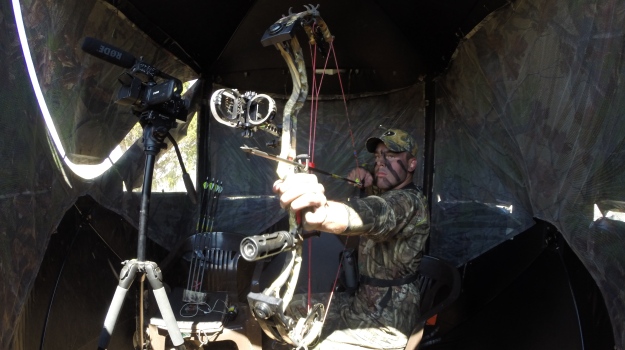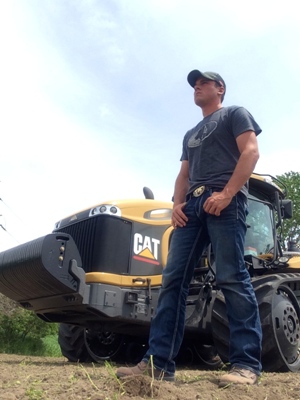
Editor’s Note: Kyle Meyer from Milan, Michigan, has been a Mossy Oak pro for the last 5 years. “I became a pro when I was 19, and I'm 24 now,” Meyer says. Like many of us, Meyer went with his dad deer hunting when he was about 4-years old and started hunting on his own when he was 12, the age at which he could hunt with a bow in Michigan. He’d rather hunt with a bow, but he also hunts with a gun in his home state, one of the top three states for numbers of deer hunters in the U.S. Although Meyer has 6,000 acres of private land to hunt, that only includes about 200 acres of woodlots. According to Meyer, “My favorite Mossy Oak pattern is Treestand, because most of the time, I'm hunting from a tree stand. When I'm in a ground blind, from the waist up, I’ll wear a solid black shirt, gloves and face paint and my Treestand pants. I also wear Mossy Oak Infinity for turkey season, and I like Mossy Oak Bottomland.”
When most people hunt agricultural fields, they usually hunt the edges, the trails leading from the woodlot to the field or the fence line between the field and the bedding area. But, I never hesitate to set-up a ground blind out in the field, especially a corn field. Standing corn provides food and cover for the deer. When the corn is more than head-high, the deer can stay in it all day long. They can bed there and find shade. Most of the time, when I’m setting-up a ground blind in a corn field, I’ll put the ground blind two to three rows inside a field of standing corn. As we all know, deer are edge feeders, and they like to feed along the edges of standing corn. I've been most successful setting-up a ground blind inside the standing corn beside a place where the corn just has been harvested, and corn is still left on the ground from the combine. When I cut corn stalks down where I set-up my blind, I use zip ties to place those stalks up against my blind to look like they're still standing.
Another place I like to set-up a ground blind is on the ends of the cornfield where the deer are coming out of the woods into the corn. By putting the blind two or three rows into the corn that’s still standing, I usually can get a 30 - 40 yard bow shot as the deer comes out of the woods into the corn. I've learned that the trails where the deer go into or come out of the corn are most often where you'll take your biggest bucks.
One of the most-important elements for hunting a ground blind in standing corn is to not let the buck know that you're hunting him. When I took my biggest buck, which was 162-1/8 points, I could have walked only 300 yards to my ground blind from my truck. But I would’ve walked right by the edge of the woods where I thought the deer was bedding and by the fence line where I thought the deer was coming into the cornfield. Instead, I walked down a row of the standing corn for 1/2-mile to get into the blind without the deer seeing or smelling me. I think one of the most-important elements of hunting from a ground blind is the trail you take to the blind. I always come from the downwind side, and I always make sure I have enough cover around the blind and in front of the door where I go into the blind, so that even if the deer is standing there looking at the blind when I get in it, he can’t see me.
 In Michigan where I hunt, a 3- or a 4-year old buck has a Ph.D. in hunter dodging. Many of the hunters who hunt around us will harvest any buck. So, the only way for a deer to survive to get into the older-age class is to become a master of hunter dodging. That’s why the buck’s not knowing you're hunting him is so important when trying to take an older-age-class deer. Ground blinds can be very effective for taking mature bucks, if you make sure the deer don’t see you go to the blind, can’t tell there is a blind where you’re set-up and can’t see or smell you coming out of the blind.
In Michigan where I hunt, a 3- or a 4-year old buck has a Ph.D. in hunter dodging. Many of the hunters who hunt around us will harvest any buck. So, the only way for a deer to survive to get into the older-age class is to become a master of hunter dodging. That’s why the buck’s not knowing you're hunting him is so important when trying to take an older-age-class deer. Ground blinds can be very effective for taking mature bucks, if you make sure the deer don’t see you go to the blind, can’t tell there is a blind where you’re set-up and can’t see or smell you coming out of the blind.
One aspect of hunting agricultural fields that I don’t think hunters understand is that if you go to the field before daylight and walk down the edge of the field, the deer out in the field and the edge of the woodlot will see you. So, you're better off to go to a ground blind that’s set-up in a corn field by walking through the corn where the deer can’t see you getting in the blind. If you’re hunting from a tree stand in the woods, your best bet will be to walk to and from that stand in the woods than to walk down the edge of a field and go to that stand. Yes, generally walking down the edge of a field is easier. But when you're on an field edge, the deer can spot you much easier as you're going to and from your stand than they can if you walk through the corn and get in the ground blind, or walk through the woods to get in a tree stand.
Because we don’t have a lot of woods on the 6,000 acres that I hunt, I hunt pinch points. I like to set-up where a fence line goes into the woods and the corner of a field. This year I'm hunting a ditch where a small creek runs between two pieces of CRP land. I wear my waders and walk down the creek. Then when I get close to my tree stand, I take my waders off, put my boots on and climb into my tree stand. Using this tactic, I'm out of sight of the deer bedding in the CRP land, and I've only left about 2 yards with human odor at the place where I leave my waders, put on my boots and climb into my tree stand.
Right now I'm hunting a 6x5 (11-pointer) that I saw at 45 yards from this stand on opening day of bow season. However, the buck was facing me, and I didn’t feel comfortable taking a head-on shot at that distance. I’ve also got a small BioLogic food plot on the edge of the creek. The day before this interview for the Mossy Oak webpage, a buck walked down the side of the creek and under my stand, went down below me, jumped across the creek and then went out into the CRP land. Although I only have about 200 acres of woodlots to hunt, I have 18 tree stands set-up, and I use my ground blinds when I see bucks out in the corn.
To learn more about hunting, check out John E. Phillips’ new eBook and print book, “Bowhunting Deer: Mossy Oak Pros Know Bucks and Bows.” You also can download a free Kindle app that enables you to read the book on your iPad, computer or Smartphone.
For information on making jerky from your deer to provide a protein-rich snack, you can download a free book from http://johninthewild.com/free-books.
Day 4: Kyle Meyer's First Buck with a Bow



























